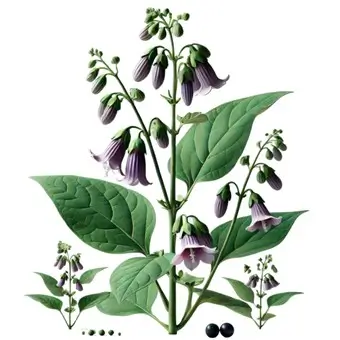General Introduction to Belladonna:
- Belladonna alkaloids are tropane alkaloids recognized for their potent anticholinergic activity.
- They are used in clinical practice for their mydriatic, antispasmodic, and anti-secretory effects.

Synonyms:
- Common Name: Deadly nightshade alkaloids
- Scientific Name: Atropa belladonna alkaloids
- Other Names: Atropine, Hyoscyamine, Scopolamine alkaloids
Biological Source:
- Plant: Derived from the dried leaves and roots of Atropa belladonna.
- Family: Solanaceae
Composition:
- Major Alkaloids: Atropine, Hyoscyamine, Scopolamine.
Chemistry & Chemical Classes:
- Chemical Class: Tropane alkaloids
- Structure:
- Characterized by a bicyclic tropane ring with ester linkages.
- Atropine is a racemic mixture of d- and l-hyoscyamine.
- Solubility: Lipid-soluble, which facilitates penetration into the central nervous system.
Therapeutic Uses:
-
Atropine:
- Used as a mydriatic (pupil dilator) in ophthalmology.
- Treats bradycardia (slow heart rate) and reduces secretions during surgery.
-
Scopolamine:
- Used to prevent motion sickness and as a sedative.
-
Hyoscyamine:
- Acts as an antispasmodic for gastrointestinal and urinary conditions.
Commercial Applications of Belladonna:
- Atropine: Found in eye drops for ophthalmic procedures.
- Scopolamine: Formulated as transdermal patches for motion sickness management.
- Additional antispasmodic and anticholinergic drugs are available.
Click Here to Watch the Best Pharma Videos

